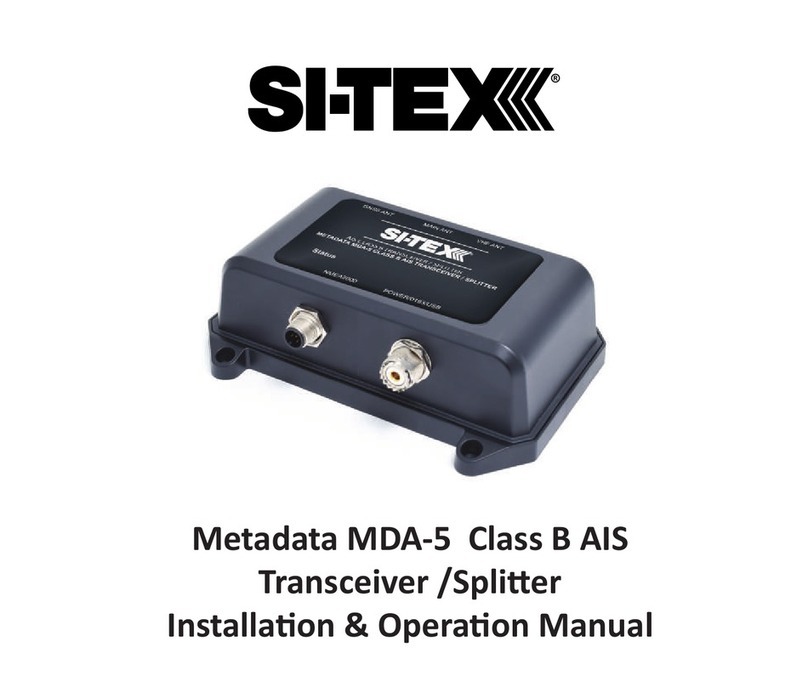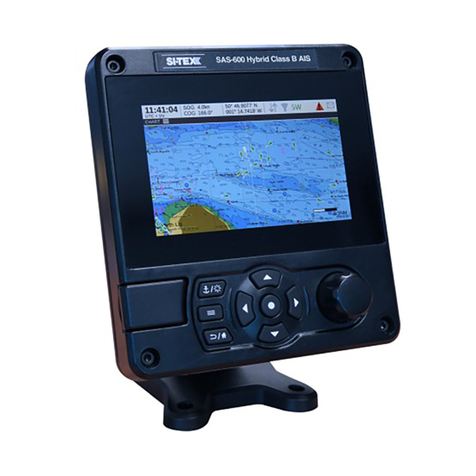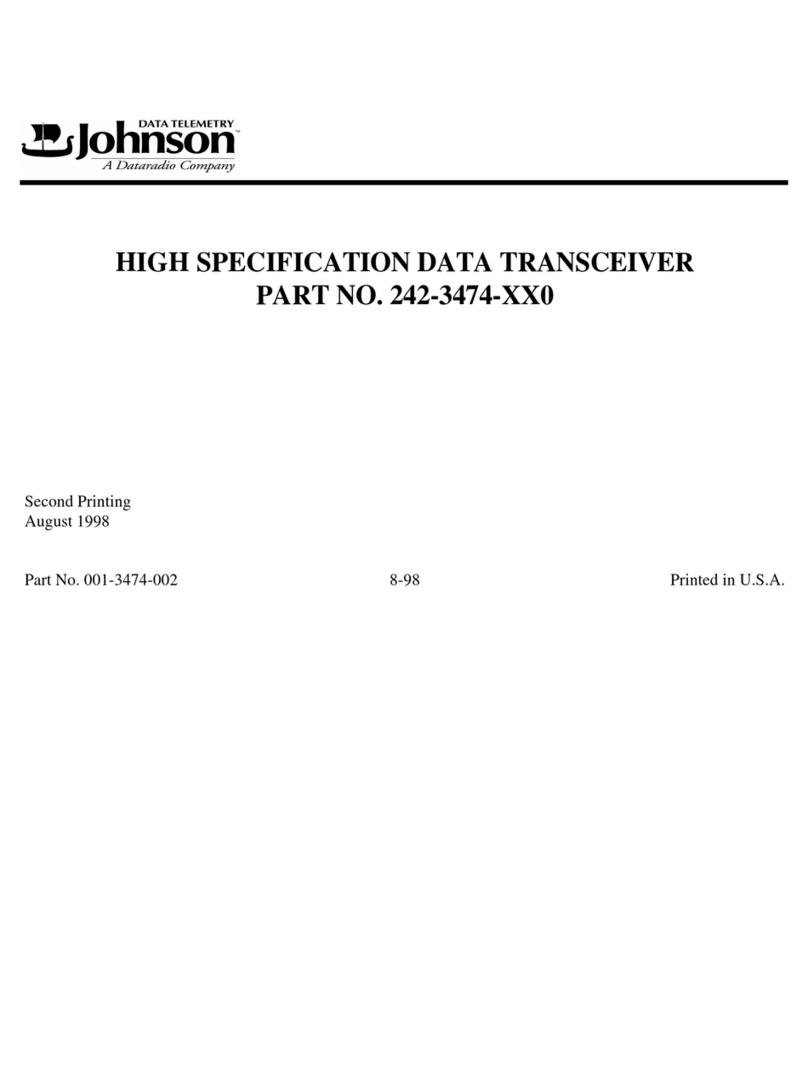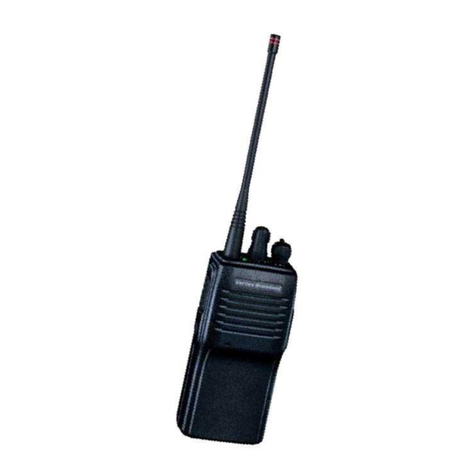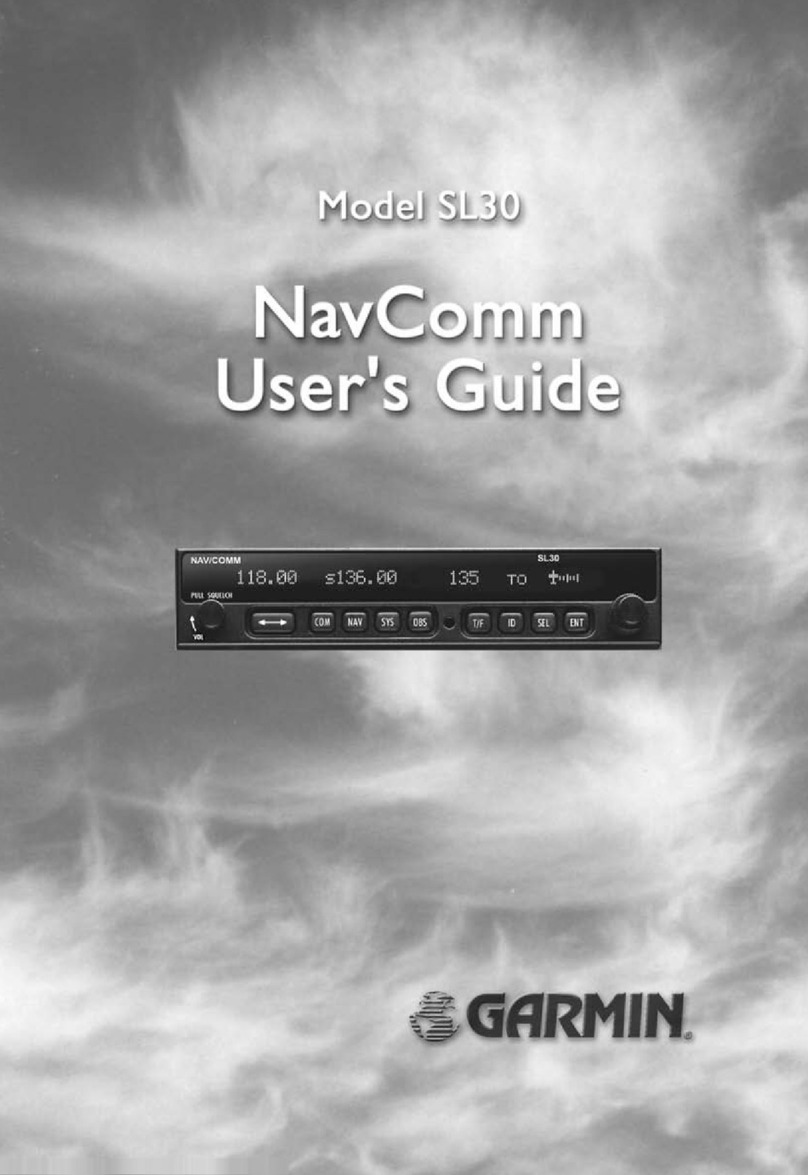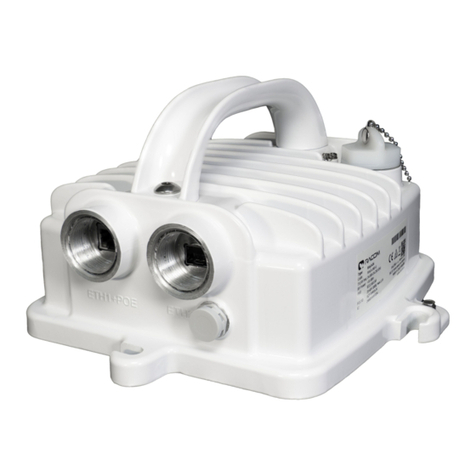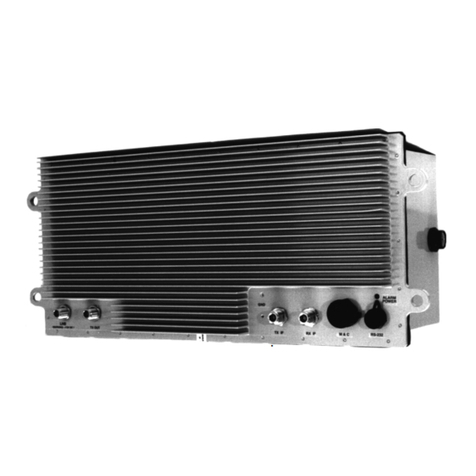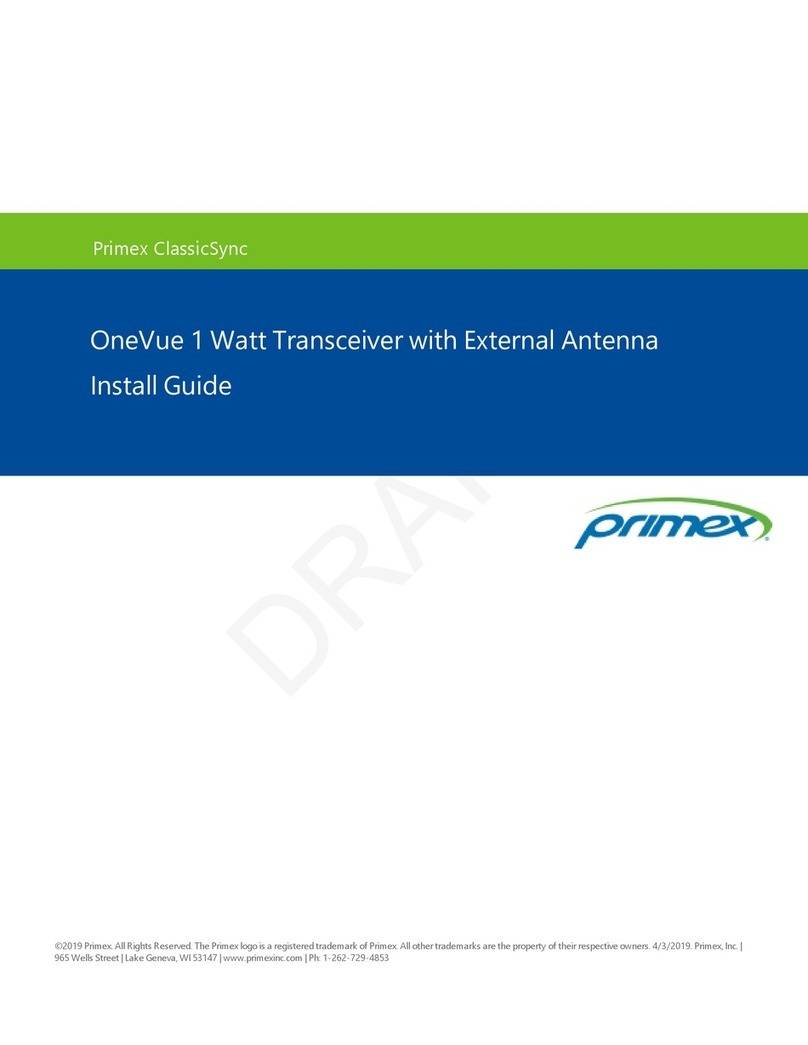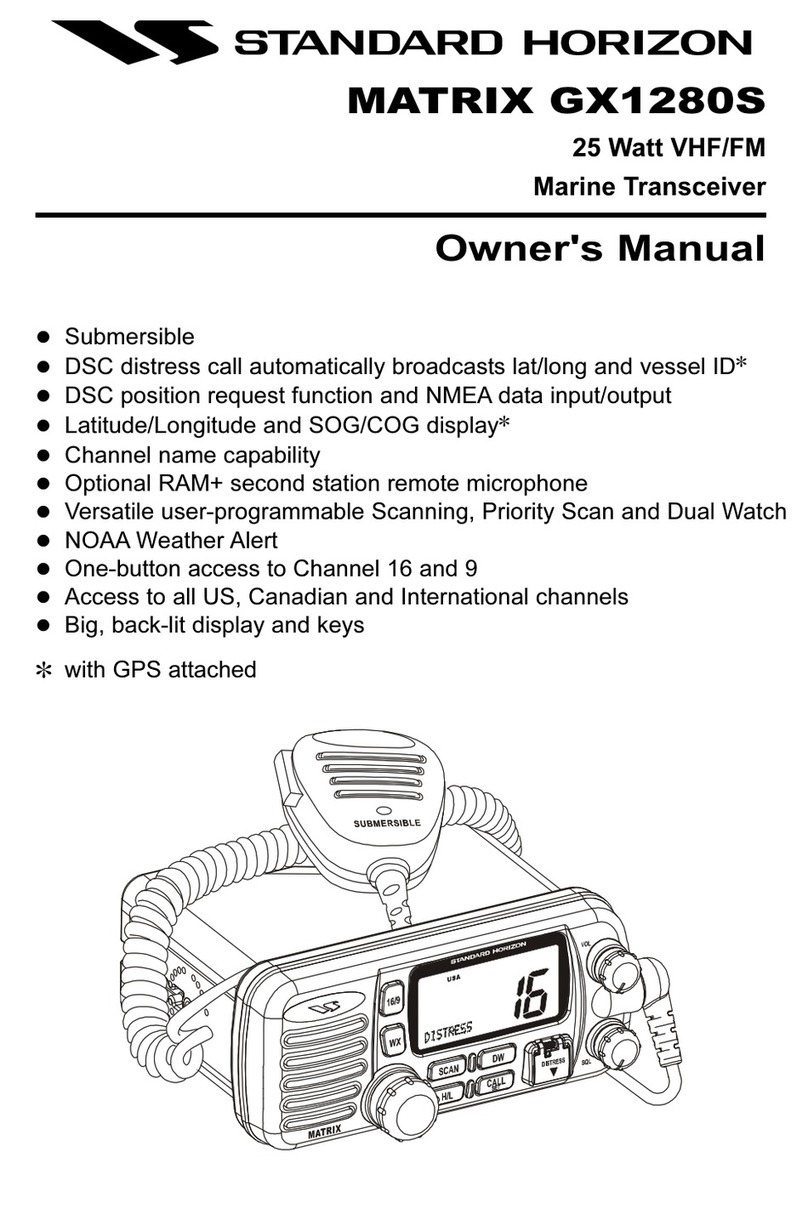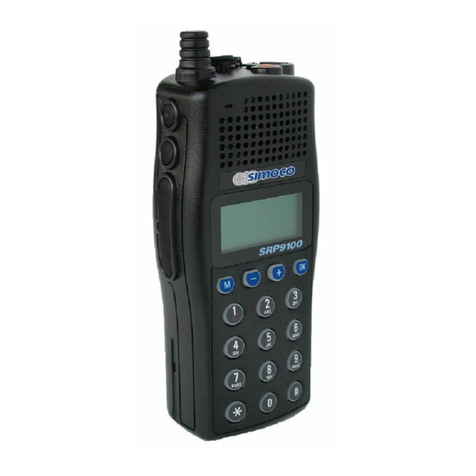Sitex DSC-900 User guide

OWNER’S
HANDBOOK
DSC-900
UIC

DSC-900 1
TABLE OF CONTENTS
LICENSE INFORMATION...........................................................................................................3
FCCRadioLisence....................................................................................................................3
RadioCallSign...........................................................................................................................3
MMSINumberInformation...................................................................................................3
FCC NOTICE.....................................................................................................................................3
FCCDigitalDeviseCompliance............................................................................................3
FCC Radio Frequency Compliance RequirementsandWarnings...............................4
1. INTRODUCTION........................................................................................................................5
1.1EquipmentRequired..........................................................................................................5
1.2EquipmentSupplied..........................................................................................................5
1.3OptionalEquipment...........................................................................................................5
2. BASIC RADIO COMMUNICATION PROCEDURES...................................................6
2.1Using Channel16................................................................................................................6
2.2Calling AnotherVessel......................................................................................................7
2.3ProhibitedCommunication..............................................................................................7
3. INSTALLATION..........................................................................................................................8
3.1Transceiver............................................................................................................................8
3.2Antenna..................................................................................................................................8
3.3PowerConnection...............................................................................................................8
3.4Rear PanelCables................................................................................................................9
3.5OptionalFM-02 FlushMountKitInstallation............................................................10
4. OPERATION...............................................................................................................................11
4.1PowerOn/Off....................................................................................................................11
4.2Volume and Squelch........................................................................................................11
4.3Keypad.................................................................................................................................12
4.4ChannelSelection..............................................................................................................12
4.5ChannelBanks...................................................................................................................13
4.6Wx Channels......................................................................................................................13
4.7Wx Alert..............................................................................................................................13
4.8 Priority Channel(16/09)..................................................................................................14
4.9PTT........................................................................................................................................14
4.10H/L.....................................................................................................................................14

2 DSC-900
4.11ChannelScanning...........................................................................................................14
PriorityScan.................................................................................................................14
AllScan..........................................................................................................................15
MemoryScan...............................................................................................................15
4.12MMSI Set...........................................................................................................................17
4.13Directory............................................................................................................................18
5. DSC OPERATION.....................................................................................................................21
5.1DSC Monitor......................................................................................................................21
5.2GPSOperation...................................................................................................................21
5.3Sendinga DistressCall.....................................................................................................22
5.4Receivinga DistressCall..................................................................................................23
5.5Normal DSC Calls.............................................................................................................24
AllShip'sCall...................................................................................................................24
DirectoryCall...................................................................................................................25
NewCall...........................................................................................................................26
LastCall.............................................................................................................................28
PositionSend(P1)...........................................................................................................29
PositionRequest(P2)......................................................................................................29
5.6ReceivingDSCCalls..........................................................................................................31
AllShip'sCallReceived.................................................................................................31
IndividualCallReceived...............................................................................................32
GeographicCallReceived.............................................................................................32
PositionSendReceived..................................................................................................32
PositionRequestReceived............................................................................................33
6. SPECIFICATIONS.....................................................................................................................34
7. CHANNEL ASSIGNMENT....................................................................................................36
CERTIFICATE OF LIMITED WARRANTY..........................................................................39

DSC-900 3
LICENSEINFORMATION
FCC Radio License
In U.S. waters, vessels which are not required to carry radio equipment are not
required to have an FCC (Federal Communications Commission) ship station license
for a VHF marineradio.
However, any vessel required to carry a marine radio on an international voyage,
carrying a HF single side band radio telephone or marine satellite terminal must have
an FCC license.
License application forms for ship and land stations can be downloaded free from the
FCC web site at this address: www.fcc.gov/formpage.html. You may also order
copies of these forms bycalling the FCC Forms Distribution Centerat 1-800-418-3676.
Radio Call Sign
At this time, the FCC does not require recreational boaters to have a ship radio station
call sign. The U.S. Coast Guard recommends using the boat's registration number and
state.
MMSI Number Information
The BoatU.S. MMSI Program has been certified by both the Federal Communications
Commission (FCC) and the U.S. Coast Guard to assign MMSI numbers to vessels with
DSC capable radios. To obtain and register your free MMSI number, the Coast Guard
recommends logging onto http://www.boatus.com/mmsi/ and following the
instructions.
FCCNOTICE
FCC Digital Device Compliance
This device complies with Part 15 of the U.S. Federal Communications
Commission (FCC) Rules. Operation is subject to the following two conditions:
(1) this device may not cause harmful interference, and (2) this device must
accept any interference received, including interference that may cause
undesired operation.
Changes or modifications not expressly approved by the manufacturer could
void the user's authority to operate the equipment.
NOTE: This equipment has been tested and complies with Part 15 of the FCC
Rules. This specification provides reasonable protection against harmful

4 DSC-900
interference in a residential installation. This equipment generates, uses and
can radiate radio frequency energy and, if not installed and used in accordance
with the instructions, may cause harmful interference to radio communications.
However, there is no guarantee that interference will not occur in a particular
installation. If this equipment does cause harmful interference to radio or
television reception, which can be determined by turning the equipment off
and on, the user is encouraged to try to correct the interference by one or more
of the following measures:
•Reorient or relocate the receiving antenna.
•Increase the separation between the equipment and receiver.
•Connect the equipment into an outlet on a circuit different from that to
which the receiver is connected.
•Consult your dealer or an experienced technician for help.
FCC Radio Frequency Compliance Requirements and Warnings
When operating your marine radio transceiver, you should know that the
antenna radiates radio frequency (RF) energy. This radio was designed to meet
the FCC’s rules and regulations for the maximum permissible exposure to
radio frequency energy. This design was tested and found to be compliant
with the strict requirements established by the FCC.
DO NOT operate the radio without a proper antenna attached, because this
may damage the radio and may also cause you to exceed FCC RF exposure
limits. Antenna types suited for this radio are described in the installation
section.
DO NOT transmit for more than 50% of the total radio use time. Transmitting
more than 50% of the time can cause FCC RF exposure compliance
requirements to be exceeded. The radio is transmitting when the “TX
indicator” is displayed on the screen. You can cause the radio to transmit by
pressing the "PTT" (Push To Talk) switch.
IMPORTANT: The antenna(s) used for this transmitter must be installed to
provide a separation distance of at least 91 cm (37 inches) from all persons
(including passengers). The antenna(s) must not exceed an antenna gain of 3
decibels (dB) and must not be co-located or operating in conjunction with any
other antenna or transmitter.

DSC-900 5
1.INTRODUCTION
Congratulations on your purchase of the DSC-900. It is an advanced marine VHF
communication transceiver offering Digital Selective Calling. It is designed for
operation in the marine VHF FM frequency band. The operating frequency range is
156.025to 163.275MHzwhich includesall USA,Int’l, Canada andWx channels.
The transceiver has Digital Selective Calling (DSC) capabilities. Distress, All Ship’s and
IndividualDSC call formatsare supported.
Other features include Position Send/Request, all channel scanning, priority channel
scanning, memory channel scanning, one button instance access to channel 16/09,
large selector knob and microphone with UP/DOWN keys.
1.1 Equipment Required
The minimum equipment required for two way voice and DSC VHF radio
communication with vessels and shore stations includes:
•VHF radio communication transmitter and receiver designed and approved for
marine VHF communication use.
•VHF antenna and connecting cable. Use a good quality unity gain antenna for
best range performance.
•Power source suitablefor the VHF transmitterand receiver.
•For Digital Selective Calling (DSC) VHF communication radios, connection to a
GPS receiver that provides latitude and longitude coordinates and UTC time for
distress messages.
1.2 Equipment Supplied
•DSC-900 MarineVHF Transceiver
•Microphone with UP/DOWN keys
•Mounting Bracket with knobs
•Microphone Hanger
•Power Cable with in-linefuse (6.3 Amp)
•Owner’s Handbook
1.3 Optional Equipment
•FM-02Flush Mount Kit

6 DSC-900
2. BASIC RADIO COMMUNICATION PROCEDURES
Distress or emergency calls may be made either manually or automatically. Sending
distress calls automatically uses the Digital Selective Calling (DSC) functions of your
transceiver and requires as operating and properly connected navigationreceiver. The
following procedures are for sending voice distress messages manually. Sending an
automatic distress callis described in the DSCsection of this manual.
2.1 Using Channel 16
Channel 16 is the Calling and Distress channel. An emergency may be defined as a
situation that threatens human life or property. In such situations, make sure your
transceiver is turned On and set the channel selector to Channel 16. Then use the
following procedure to make a distress call. The total transmission should not exceed 1
minute.
1. Press the microphone Push To Talk button. Speak slowly and clearly into the
microphone: “Mayday, Mayday, Mayday, this is [your vessel’s name], [your
vessel’s name], [your vessel’s name]”.
2. Then repeat once: “Mayday,[your vessel’s name]”.
3. Continue by reporting your position in latitude and longitude or by reporting
your bearing (true or magnetic, specify which) and distance from a prominent or
well known landmark, geographic feature oraid to navigation.
4. Explain the nature of your emergency (fire, sinking, collision, grounding, health
condition, injury, etc.).
5. Report the kind of assistance yourequire (fire, medical aid,pumps, etc.).
6. State the number of people aboard and the conditionof any injured.
7. Estimate the seaworthiness and condition of your vessel.
8. Describe yourvessel: length, type, color and any distinguishing feature.
9. End the message by saying “Over”. Release the Push To Talk button and listen for
areply.
10. If there is no reply, repeat the above message procedure. If there is still no
response, try another channel.

DSC-900 7
2.2 Calling Another Vessel
Channel 16 may be used to establish initial contact with another vessel. However, its
most important use is for voice emergency messages. Channel 16 must be monitored
at all times except when engaged in actual communication on another channel.
Channel 16 is monitored by international search and rescue (SAR) authorities,
National Coast Guards and by other vessels. Use of Channel 16 for calling or hailing
must be limited to initial contact only. Calling should not exceed 30 seconds and may
berepeated 3 timesat 2minute intervals.
Prior to making contact with another vessel, determine which channel will be used for
continued communication after the initial contact. Monitor the desired channel for
traffic and, when clear, switch to Channel16 to make initial contact.
Listen for traffic on the Calling Channel (16). If clear, press the Push To Talk (PTT)
button on the microphone. Speak the name of the vessel you are calling followed by
“this is” and the name of your vessel and your call sign. Release the PTT and listen for
a reply. When the other vessel returns your call, acknowledge the call with “go to”, the
number of the new channel and “over”. Switch to the new channel and listenfor traffic.
If necessary, wait for traffic to clear, and then call the other vessel. As communication
proceeds, end each transmission with “over”. When communication with the other
vessel is completed, end the last transmission with your call sign and the word “out”.
It is not necessary to end each transmission with your call sign, just give your call sign
at the beginning andend of each contact.
Remember to switch to Channel 16 when not actively communicating on another
channel.
2.3 Prohibited Communication
The following communications are prohibited by regulations and violators are subject
to penalties.
•False distress or emergency messages(including false DSC distress).
•Messages to “any vessel” exceptin emergencies and radio tests.
•Messagesto or froma vessel on land.
•Transmissionwhile on land.
•Obscene,indecent, or profanelanguage.

8 DSC-900
3.INSTALLATION
3.1 Transceiver
Your DSC-900 transceiver is designed to withstand the rigors of the marine
environment. However, selecting a mounting location affording some protection from
the elements will prolong the life of connectors, controls and the liquid crystal display
(LCD).
Select a location within easy reach and view of the operator and away from your
vessel’s compass. Locate the microphone to avoid entanglement with steering or
engine controls, both when in use and whenstowed. Also, consider routing of antenna,
power and NMEA interfacecables. Mount the transceiver securely to asolid surface.
3.2 Antenna
Proper installation of a quality VHF antenna is very important to reliable radio
communication. A good quality unity gain antenna is recommended for maximum
range performance. In general, antennas should be located as high as practical and
separated as much as possible from other antennas and structures. The minimum
distance to other objects is 1 meter. Route the antenna cable away from other electronic
equipment and do not bundle the antenna or power cable with other wiring,
especially transducer cables for depth sounders and fish finders. For cables longer than
10 meters, RG-8/U coaxial cable must be used. Mount the antenna and install the
connector(s) in accordance with manufactures instructions. Connect the antenna cable
to the RF output connector on the rear panel of the transceiver.
3.3 Power Connection
CAUTION
Reverse polarity connections can damage your transceiver
The power cable for your transceiver must be connected to the ship’s main powerbuss.
Connect the Red wire to the positive (+) terminal and the Black wire to the negative (-)
terminal. Connect the barrel terminals on the power cable to the matching color wires
and terminals extending from the rear panel of the transceiver.

DSC-900 9
3.4 Rear Panel Cables
The white and black cables on the rear panel are provided for connecting an external
speaker. Use an 8 Ohm speaker rated for at least 3 Watts and suitable for the
environment at the chosen location.
Other cables are provided for connecting an operating GPS navigation receiver, in
order for the position reporting/transferring features of your transceiver to function.
Refer to your GPS navigation receiver manual for information about its NMEA
output/inputsettings andconnections.
Wire Color Description Connection
White External speaker (+) Connect to external 8 Ohm audio speaker
Black External speaker (-) Connect to external 8 Ohm audio speaker
Brown NMEA Rx (+) Connect to NMEATx (+) of GPS
Red NMEA Rx (-) Connect to Ground/NMEA Tx (-) ofGPS
Orange NMEA Tx (+) Connect to NMEARx (+) of GPS
Yellow Ground/NMEA Tx (-) Connect to Ground/NMEA Rx (-) ofGPS

10 DSC-900
3.5 Optional FM-02 Flush Mount Kit Installation
1. Cut the dash board using a template sheetincluded in the kit.
2. Set the radio in the cut dash board.
3. Rotating the longer screw and set it to the hole of the plastic mount block. Firmly
attach the bolt foot rotating to the top of the screw. (See Fig. 1)
4. Firmly fix the plastic mount block on the either side of the radio using shorter
screw. Don’t forget to attach the washer. (See Fig. 2 and Fig. 3)
5. Fasten the longer screw to fix the radio to the dash board firmly. (Fig. 4)
6. The same works should bedone to the otherside too.
Fig.1
Bolt foot
Plastic mount block
Longer screw
Fig.2
Shorter screw
Washer
Fig.3
(+) screw driver
Fig.4

DSC-900 11
4.OPERATION
4.1 Power On/Off
Power to the transceiver is controlled with the VOLume knob. When the VOL knob is
the full CCW position, the unit isturned Off.
To turn the transceiver On:
•Rotate the VOLume knob CW until it clicks over the detent. The LCD backlight
illuminates and the Power-Onscreen appears.
After approximately two seconds, the Normal Communication screen appears in
thedisplay.
The default Priority channel (CH16 or 09) is displayed in the LCD. For the first
time Turn On, it is CH16. The radio’s Orange lighting is always On. There is no
contrastcontrol.
USA DSC
MON
PRI
GPS
MEM
To turn the transceiver Off:
•Rotate the VOL knob CCW until it clicks over the detentto the OFF position.
4.2 Volume and Squelch
The VOLume and SQuelch controls have each knob. They are independent controls
but work together to control audio output from the speaker. The volume control set
the loudness of sound from the speaker and the squelch control is used to mute
background noise when no received signals are present.
Toproperly set theVOL and SQ controls:
•Rotate the SQ knob fully CCW.
•Rotate the VOL knob CW until background noise is plainly heard.

12 DSC-900
•Slowly rotate the SQ knob CW until the noise is muted (squelched). Then adjust
the control slightly more CW (approximately 1/8 turn). Use care not set to the
SQ control more CW than necessary orweaksignals may be heard.
Some channels exhibit more background noise than others, so it may be necessary to
readjust the squelch setting when changing channels orwhen scanning.
4.3 Keypad
A tone is emitted when any of the 6 keys are pressed. A 3-beep error tone is emitted if
the key press is not allowed. Some functions require a holding down of a key. A single
beep is emitted, then after the hold down timeout, a second beep will be heard and the
mode entered. The basic purpose for each keyis as follows:
Used for selecting channeland menu.
H/L Use to toggle transmitter power between 25 watts and 1 watt output.
Certain channels are restricted to 1 watt maximum powerand will cause the
error beep if the HI/LO key is pressed.
WX Switches to the Wx channel mode. Also toggle Off/On the Wx Alert
function by pressing in Priority or MemoryScan modes.
16/9 Selects the Primary Calling 16/09 or the last channel used. Also cancels DSC
and Emergency /Distress calls.
SCAN Can be used alone or with the MEM key to select Priority Scan, Memory
Scan or All Scan.
MEM Stores MMSI numbers. Also stores channels in the scan memory bank, and
when used with the SCAN key, starts Memory Scan.
CALL Initiates DSC operation screens by pressing.
4.4 Channel Selection
There are two ways to change channels:
•Rotate the SELECTOR, or press the UP/DOWN keys on the MIC. The
UP/DOWN keys on the MIC will always change channels except when being
used in sub-modes.
Refer to the enclosed channel chart for proper usage and understanding. In USA and
Canada, the Wx channels are available. Wx channels are not available for the
International ChannelBank.

DSC-900 13
The Aannunciator in the Radio’s LCD indicates an “ALTERNATE” Channel usage
and usually indicates a SIMPLEX channel is tuned and normal voice ship-to-ship
communicationis appropriate. Ifthe Aannunciator is OFF, the radio is sometimes
operating in the DUPLEX Mode - the Transmit and Receive frequencies are different.
4.5 Channel Banks
To switch channel banks – USA,Int’l and Canada:
•Press the H/L key and WX key at the same time. The selected USA, Ior C
annunciator will come On.
4.6 Wx Channels
ToswitchtoWxmode:
•Press the WX key. Wx annunciator appears in the LCD and now you are in the
Wx mode. The last used Wx channel alwaysappears first.
•Rotate the SELECTOR to change the Wx channels.
To exit from Wx mode:
•Press the WX key. The radio returns to the previous working channel.
4.7 Wx Alert
The Wx Alert is a 1050Hz tone burst that is transmitted from the NOAA Weather
station. A special circuit in the radio detects this tone and during scanning modes
(except ALL SCAN) a loud 2-tone warning will sound. Select the Wx channel before
startinga PriorityScan or Memory Scan.
The alarm is cancelled by pressing any key. The radio stops scanning and switches to
the Wx channel to hear the warnings. You know the radio is scanning the Wx channel,
if you see the Wx annunciator flashOn/Off in the LCD during the scanning process.
To toggle Off/On WxAlert function:
•Press the WX key in Priority Scan or Memory Scan modes.
USA DSC
MON
PRI
GPS
PSCN
Wx ALERT

14 DSC-900
4.8 Priority Channel (16/09)
The Priority channel can be set as channel 16 or channel 09. Default priority channel is
channel16.
To switch the priority channel:
•Press and hold the 16/9 key until priority channel is switched to other channel.
Thenew priority channelis remembered, even if turning Off the radio.
USA DSC
MON
PRI
GPS
MEM
USA DSC
MON
PRI
GPS
A quick press of the 16/9 Key immediately selects the priority channel (16 or 09) with
high(25W) Tx power.Pressing againthe 16/9 key selects the last used channel.
4.9 PTT
This Key is on the MIC. Pressand hold it down to activate RF radio transmission at the
selected RF power level. There is a 5-minute maximum Tx timer, per FCC regulations.
4.10 H/L
This key toggles between 25W and 1W. If the Lo annunciator is OFF, the radio will
transmit at 25Watts. Some channels are restricted to 1 W maximum power and will
cause the error beep if the H/L keyis pressed.
USA DSC
MON
PRI
GPS ALo
4.11 Channel Scanning
There are three channel scanning modes; PriorityScan, AllScan and MemoryScan.
Priority Scan
The Priority Scan function scans the Priority channel, Wx channel and the last selected
working channel.
To activate the Priority Scan:
•Press the SCAN key. P SCN appears and three scanned channel numbers appear

DSC-900 15
alternately in the display. Wx Alert is On and can be toggled Off/On by pressing
the WX key.
USA DSC
MON
PRI
GPS A
PSCN
To exit Priority Scan:
•Press the SCAN key or press the 16/9 key.
All Scan
The All Scan function scans all channels except channel 70. (Channel 70 is the Digital
Selective Calling (DSC) channel. Voice traffic is not permitted.) If noisy or busy
channels interfere with scanning, the interfering channels may be temporarily
removed from the scansequence.
To activate the All Scan:
•Press and hold the SCAN key. ALL SCN appears and the scanned channel
numbers appear in sequence in the channel number display.
USA DSC
MON
PRI
GPS
ALL SCN
To Exit All Scan:
•Press the SCAN key or press the 16/9 key.
To delete channels from the scansequence:
•Press and hold the MEM key while the scan is halted on the offending channel.
The symbol above the MEM key means DELETE. Turning the radio Off and
On restores all channelsto the scan sequence.
Memory Scan
Memory Scan allows the user to create and scan a bank of preferred channels.
Channels may be added to or removed from the memory channel bank as desired.
Memory channels are stored individually and may be deleted individually, or the
entirebankmaybedeleted. IfthePTT button is pressed, the transceiver exits scanning

16 DSC-900
andnormal communication is resumed.
To add channels to the memory channel bank:
•Use the SELECTOR or UP/DOWN keys on MIC tochoose a desired channel.
•Press and hold the MEM key until the MEM annunciator appears. The new
channel is now added to the memory channel bank. The Priority Channel is
automatically stored in the memory channel bank and does not need to be
added.
To remove channels from the memory channel bank:
•Use the SELECTOR or UP/DOWN keys on MIC tochoose a channel.
•Press and hold the MEM key. This channel is now removed from the memory
channel bank and MEM annunciatoris gone.
To remove all channels from the memorychannel bank:
•Press and hold the MEM key while turning On the radio. This clears out the
memory channels.
To activate Memory Scan:
•Press the MEM key. And then press the SCAN key. MEM SCN appears and the
scanned channel numbers appear in sequence in the channel number display.
Scanning starts with Wx Alert On. To toggle the Wx Alert Off/On, press the WX
key while in the scan mode.
USA DSC
MON
PRI
GPS
MEM SCN
To exit Memory Scan:
•Press the SCAN key or press the 16/9 key. PTT exits the scan mode at the last
channel displayed.

DSC-900 17
4.12 MMSI Set
MMSI Set provides the entry of the 9 digit MMSI for your vessel which must be
entered in order to make DSC calls. MMSI must be obtained from government
communication authority or authorized agents.
CAUTION
If a 9-digit MMSI number has not been entered, no DSC calls are allowed.
Only one entry attempt is permitted. Please study this section and do it
properly.
To enter your MMSInumber:
•Press and hold the CALL key for 5 seconds. The ID annunciator will blink and
thenumber “0”is inthe Big Digit andthe number “16” is in thesmall digit.
NOTE
The Big Digit is the MMSI number that you are setting and the small digit is the
MMSI’s character field position. For example – “2” in the small digit represents the
2nd number fromthe left in your assigned MMSI, a “4” is the 4th number from the left,
etc.
•Use the SELECTOR or UP/DOWN keys on MIC to select the 1st digit of your
MMSI.
•Press the MEM key to advance to the 2nd digit. The small digit now displays the
2ndcharacter position with a “2”and the Big Digit displays“0”.
•Use the SELECTOR or UP/DOWN keys on MIC to select the 2nd digit of your
MMSI and Press the MEM key to advance to the next digit. Repeat this operation
until all 9digits have been enteredand verified by you.
•If there is an error in the entry procedure, press the 16/9 Key to exit this
procedureor simply turnthe radio Off. No MMSI number willbe stored.
•After you completely entered your MMSI number, hold down the CALL key for
5 seconds to store the number. The radio reverts to the Normal communication
screen and the blinking ID annunciator is gone. DSCcalls can now bemade.

18 DSC-900
ID ID ID
ID ID ID
ID ID ID
ID
MMSID = "992344513"
"START" "9"
"2"
"3"
"9"
"3" "4"
"4" "5" "1"
ID
(Shows the first digit 9 automatically)
4.13 Directory
The DSC Calling Directory is a list of location numbers and corresponding MMSI’s
that you enter and store for making DSC calls (10 MMSI’s maximum).
To store a newMMSI in an unusednumber location:
•Press the CALL key. The LAST annunciator is blinking.
•Use the SELECTOR or UP/DOWN keys on MIC toselect DIR.
•Press the CALL key. The ID annunciator is blinking. This indicates the Directory
edit mode is activated.
•Use the SELECTOR or UP/DOWN keys on MIC to select an unused location
number. If the number location is full, “FL” appears. If the number location is
emptyand available,“CL” appears.
USA DSC
MON
GPS
ID
DIR
DIR and blinking
ID show Edit mode No. 3 is full

DSC-900 19
USA DSC
MON
GPS
ID
DIR
No. 4 is empty
and usable
•Press the MEM key. The Big Digit is the MMSI number that you are setting and
the small digit isthe MMSI’s character fieldposition.
•Use the SELECTOR or UP/DOWN keys on MIC to select the 1st digit of your
MMSI.
•Press the MEM key to advance to the 2nd digit. The small digit now displays the
2ndcharacter position with a “2”and the Big Digit displays“0”.
•Use the SELECTOR or UP/DOWN keys on MIC to select the 2nd digit of your
MMSI and Press the MEM key to advance to the next digit. Repeat this operation
until all 9digits have been enteredand verified by you.
•If there is an error in the entry procedure, press the 16/9 Key to exit this
procedureor simply turnthe radio Off. No MMSI number willbe stored.
•After you completely entered your MMSI number, press and hold the CALL key
for 5 seconds to store the number. Now FL appears in the Big Digit and MMSI is
stored.
DSC
ID
DSC
ID
DSC
ID
DSC
ID
DSC
ID
DSC
ID
DSC
ID
DSC
ID
DSC
ID
"8" "7"
"7" "7" "6"
"5" "1" "0"
MMSI Number MMSI's character
field position
The example shows the MMSI “987776510” being entered.
Table of contents
Other Sitex Transceiver manuals
Popular Transceiver manuals by other brands
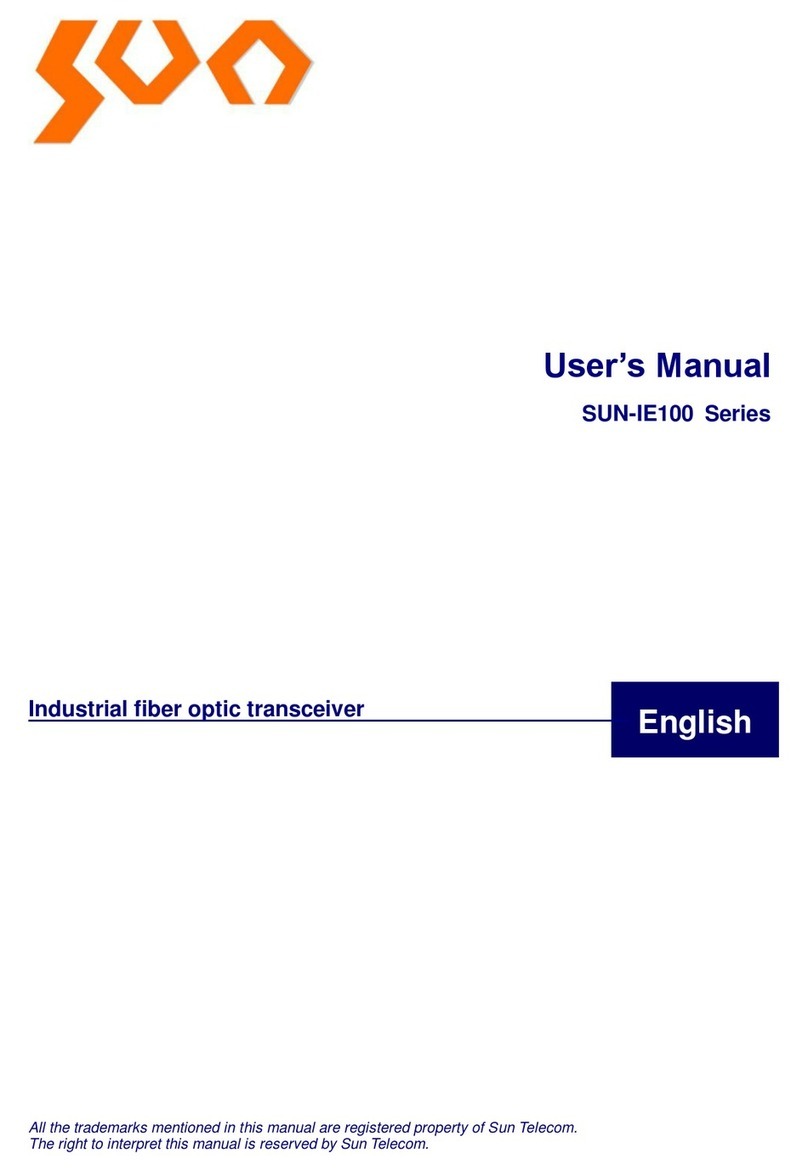
Sun Microsystems
Sun Microsystems SUN-IE100 Series user manual
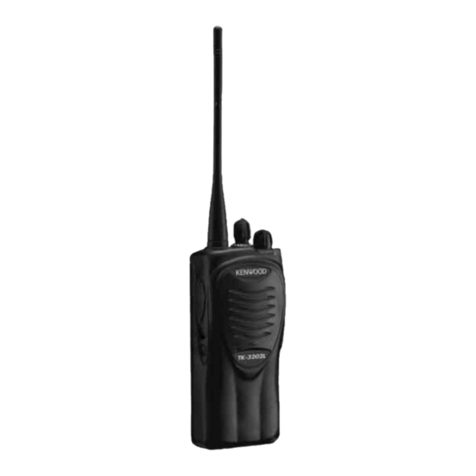
Kenwood
Kenwood TK-3202L Service manual

National Semiconductor
National Semiconductor DS36C278 s and Specifications and installation
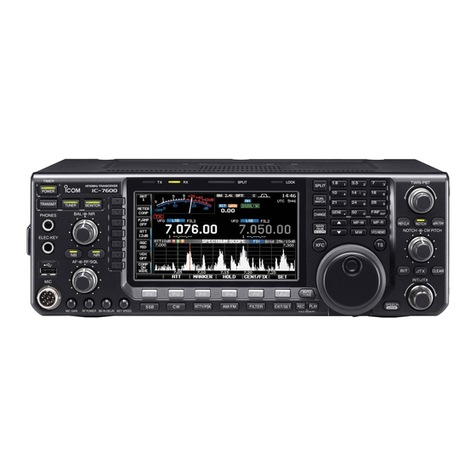
Icom
Icom IC-7600 instruction manual
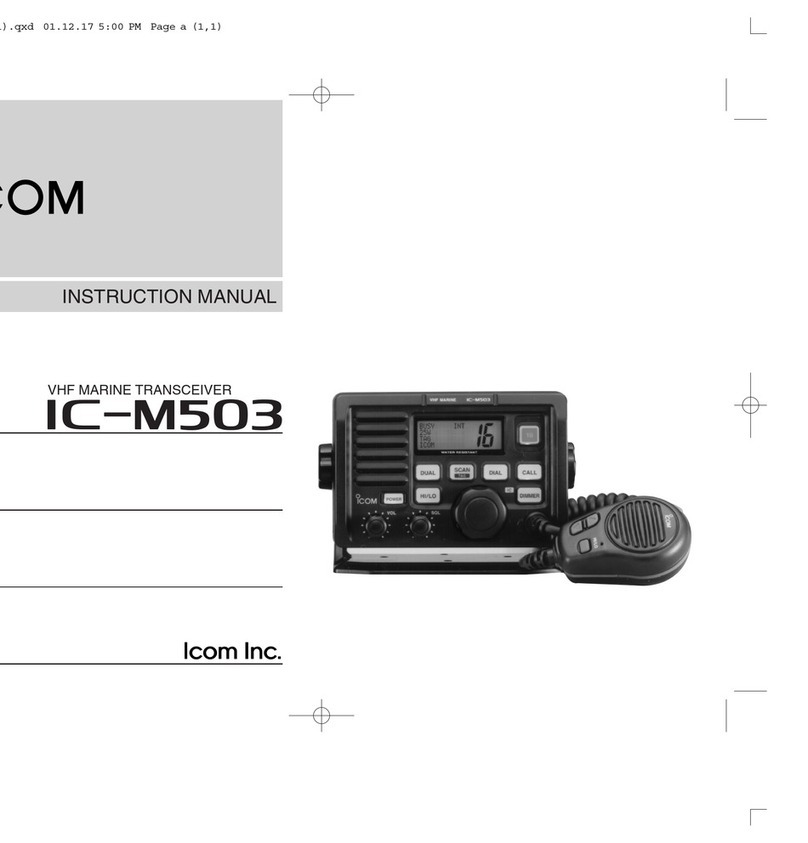
Icom
Icom IC-M503 Insrtuction manual
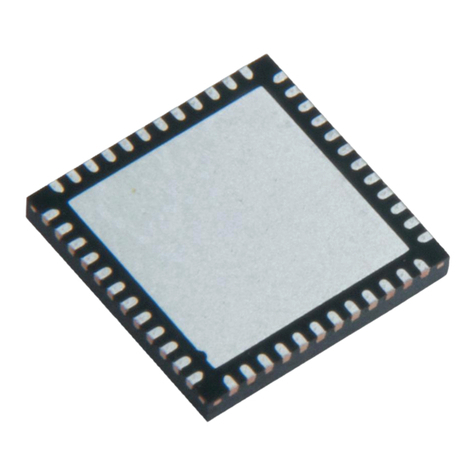
Analog Devices
Analog Devices AFDF7021 Application note
